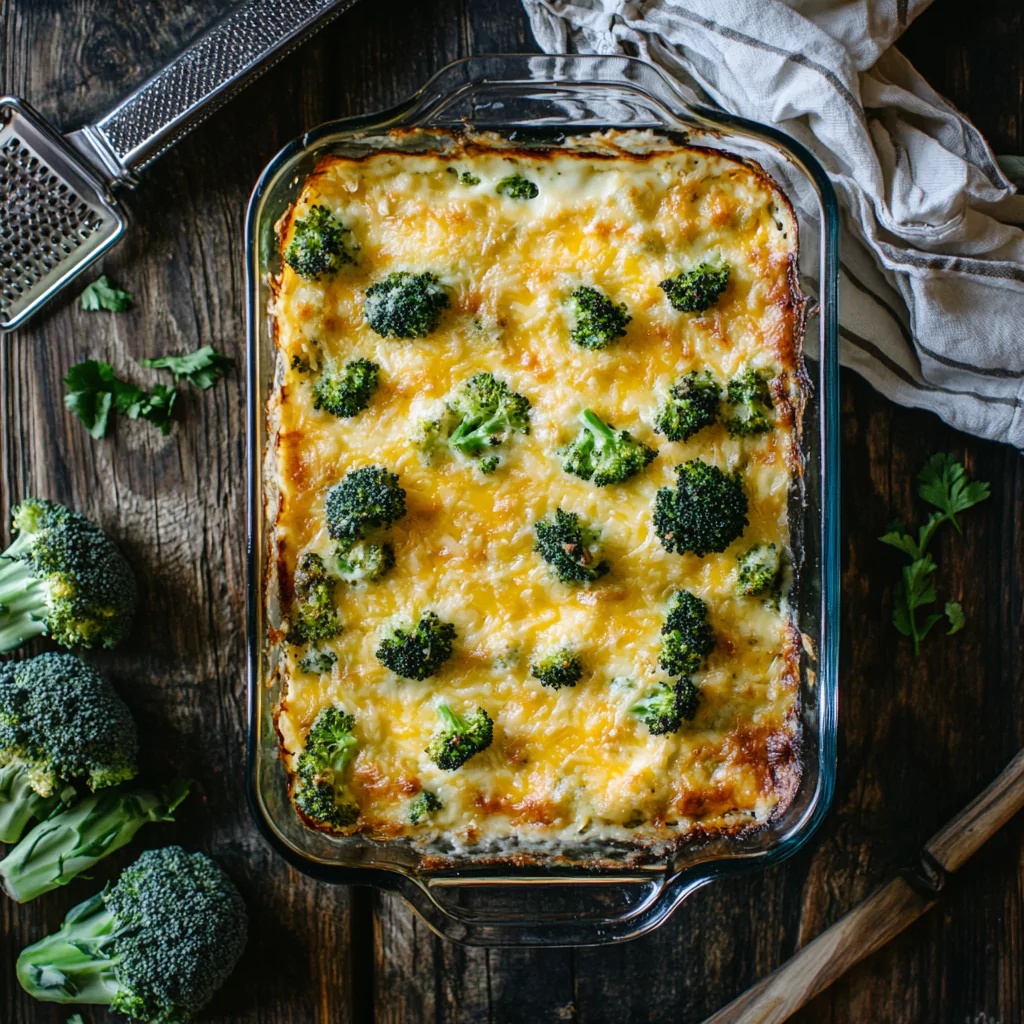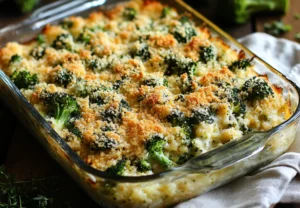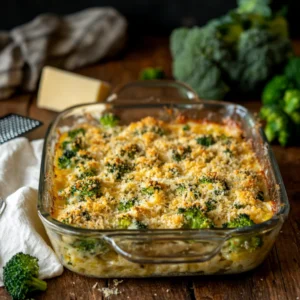Understanding the Watery Broccoli Casserole Problem
Have you ever eagerly prepared a broccoli casserole, only to be disappointed when it turns out watery and lacking the creamy texture you imagined? It can be incredibly frustrating to spend time chopping vegetables, making a sauce, and baking it to golden perfection, only to end up with a soggy mess. If you’ve ever wondered, “Why is my broccoli casserole watery?”, you’re not alone. This common issue frustrates many home cooks, but with the right techniques, it can be easily avoided. In this guide, we’ll uncover why broccoli casseroles often turn out watery and explain why fresh broccoli may be a better choice. Follow these tips to consistently achieve a perfectly creamy texture every time.
The Main Causes of a Watery Broccoli Casserole
High Moisture Content in Vegetables
Broccoli is a versatile and nutritious vegetable, but like many others, it contains a significant amount of water. When cooked, the natural moisture in broccoli is released, and if not managed effectively, it can lead to a watery broccoli casserole that misses the desired creamy texture. To avoid this and ensure your casserole is rich and satisfying, it’s essential to focus on reducing the moisture content of the broccoli before incorporating it into your dish.
Tips to Prevent a Watery Broccoli Casserole
- Blanch the Broccoli Florets Briefly
Start by blanching the broccoli florets for a short time, just enough to soften them slightly without overcooking. Once blanched, pat the florets thoroughly with a clean kitchen towel or paper towel to remove as much moisture as possible. This step helps release some of the natural water, ensuring it doesn’t accumulate in your casserole during baking. Properly drying the florets after blanching is crucial for achieving the ideal creamy consistency. - Choose Steaming Over Boiling
If blanching isn’t your preferred method, opt for steaming the broccoli instead of boiling. Boiling tends to cause the florets to absorb more water, which can then seep out during baking, leading to a soggy dish. Steaming, on the other hand, preserves the vegetable’s structure and reduces its water content without adding extra moisture, making it an excellent choice for avoiding a watery broccoli casserole. - Dry the Broccoli Thoroughly
Regardless of whether you blanch or steam, always ensure the broccoli is thoroughly dried before using it in your recipe. Lay the florets out on a towel and gently press them to absorb any remaining water. This step is vital because any surface moisture left on the broccoli will eventually make its way into the casserole, diluting the flavors and ruining the creamy texture you’re aiming for.
By following these steps, you can effectively manage the moisture in broccoli, ensuring that your casserole turns out perfectly creamy and flavorful every time. Managing water content is the key to transforming a potentially watery broccoli casserole into a dish that’s rich, satisfying, and a hit at the dinner table.
Overly Watery Sauces
A thin sauce is another common cause of watery casseroles. However, If your cheese or cream sauce lacks thickness, it won’t firm up enough during baking, resulting in a runny casserole.
How to Ensure a Thick Sauce:
- To begin with, make a roux: A classic roux made with butter and flour is a great way to thicken sauces and prevent them from becoming watery. However, Gradually add your milk or cream to create a thick, creamy base.
- Moreover, use full-fat dairy products: Reduced-fat versions of cream or cheese contain more water, leading to a less creamy, more watery final product. However, Opt for full-fat ingredients for a richer thickness.
Excessive Liquid from Ingredients
Excessive amounts of added liquids, like broth or water, are often required in casseroles and can lead to issues.
Tips to Balance Added Liquids:
- In addition, limit liquid content: Only add as much broth or water as necessary.
- Also, drain ingredients properly: If using canned ingredients like mushrooms or diced tomatoes, drain them completely before mixing them into your casserole.
The Role of Temperature in Watery Casseroles
Baking Temperature and Watery Broccoli Casserole
If the baking temperature is too low, your broccoli casserole may not cook evenly. Some parts can stay watery, while others dry out. Keeping the right temperature is key to avoiding a watery broccoli casserole and making sure it turns out creamy and delicious.
Recommended Temperature Guidelines:
- Best Temperature: Bake your broccoli casserole at 350°F to 375°F. This range ensures even cooking and allows extra moisture to evaporate.
- Avoid Underbaking: Bake the casserole for the full time until the top is golden brown and the sauce is bubbling. This step helps get the right texture without leaving any extra liquid.
Resting Time After Baking
Resting your casserole after baking is crucial. However, It allows the contents to settle, the moisture to redistribute, and the sauce to firm up.
- Finally, rest for 10-15 minutes: Let your casserole sit for 10 to 15 minutes after baking. However, This gives the excess moisture time to thicken and prevents it from running out when served.
 Ingredient-Specific Factors Contributing to Watery Casseroles
Ingredient-Specific Factors Contributing to Watery Casseroles
Frozen vs. However, Fresh Broccoli
Using frozen broccoli often leads to more moisture in the dish. Whenever possible, opt for fresh broccoli and pre-cook it lightly to remove excess water. Find out how choosing fresh over frozen can improve your casseroles.
Fresh vs. However, Frozen: What Works Best?
- Prefer Fresh Broccoli: Whenever possible, use fresh broccoli to avoid extra moisture. However, If using frozen, thaw it completely and squeeze out as much water as possible.
Dairy Choices in the Sauce
Dairy products like milk, cream, and cheese are important to casseroles, but quality matters.
Best Dairy Options for Casseroles:
- Use Full-Fat Dairy: Full-fat milk and cheese provide a creamier texture and contain less water compared to low-fat options.
- Avoid Pre-Shredded Cheese: Pre-shredded cheese often contains anti-caking agents that can affect melting and lead to a watery texture.
Practical Techniques to AvoBroccoli Casseroles
Pre-Cook Vegetables
Pre-cooking vegetables is a great way to reduce moisture before baking. For casseroles containing rice, it’s also essential to pre-cook the rice to absorb water. Discover why pre-cooking ingredients is a key step for success.
How to Pre-Cook Vegetables Correctly:
- Sauteing for Flavor: Saute the broccoli lightly in a skillet to evaporate some water while enhancing flavor.
- Baking Sheet Method: Spread broccoli on a baking sheet and bake at 400°F for about 10 minutes. However, This removes moisture without overcooking.
Choose the Right Binding Agents
Binding agents help hold the casserole together by thickening the sauce.
Common Binding Ingredients:
- Eggs: Adding an egg to the sauce helps bind the ingredients and reduce wateriness.
- Cornstarch or Flour: A tablespoon of cornstarch or flour mixed into the sauce provides extra thickening.

Troubleshooting: How to Fix a Watery Broccoli Casserole
A watery broccoli casserole can be disappointing, but it doesn’t have to ruin your dish. Even if you notice excess moisture halfway through baking, there are effective ways to salvage it and achieve the creamy texture you’re aiming for. By using simple thickening techniques, you can transform your casserole into a delicious, satisfying meal.
Add a Thickener While Baking
If your broccoli casserole is watery during baking, adding a thickener is a quick and effective solution. This step helps absorb the extra liquid and improves the overall texture of the dish.
How to Add a Thickener:
Sprinkle in Cornstarch or Flour:
- Remove the casserole from the oven.
- Mix 1–2 teaspoons of cornstarch or flour with a small amount of water to form a smooth paste.
- Stir the paste into the casserole, distributing it evenly to soak up the moisture.
- Return the dish to the oven and bake until the sauce thickens and the watery broccoli casserole is no longer a problem.
Add Extra Cheese:
- Cheese, such as shredded cheddar or mozzarella, not only enhances flavor but also thickens the dish.
- Sprinkle a generous layer of cheese on top and gently stir some into the casserole mixture.
- Bake uncovered to allow the cheese to melt and bind the ingredients, resulting in a thicker, creamier texture for your broccoli casserole.
Use Breadcrumbs or Crackers:
- Topping your casserole with breadcrumbs or crushed crackers is another way to combat excess moisture.
- Sprinkle an even layer over the top and drizzle with melted butter for a golden, crispy finish.
- As the casserole continues to bake, the breadcrumbs or crackers will absorb some of the liquid, reducing the chances of ending up with a watery broccoli casserole.
By applying these techniques, you can rescue your dish and prevent it from being a watery broccoli casserole. Whether you choose to add a thickener like cornstarch, incorporate extra cheese, or use breadcrumbs for absorption, each method ensures your casserole achieves the rich, creamy consistency you desire. With these simple fixes, your broccoli casserole will go from disappointing to delightful in no time.
Bake Longer to Fix a Watery Broccoli Casserole
If you find yourself with a watery broccoli casserole, baking it for a longer time can be an effective way to remove the extra moisture. This method helps the liquid evaporate while ensuring the dish achieves the creamy, firm texture you’re aiming for. However, it’s important to take steps to avoid overcooking, as this can dry out the casserole.
How to Bake Longer
Lower the Temperature
- Reduce the oven temperature by 25°F to slow down the cooking process.
- A lower temperature prevents the top of the casserole from overcooking while allowing the extra liquid to dry out.
- Bake for an additional 10–15 minutes, keeping a close eye to ensure the casserole doesn’t dry out too much. This small adjustment can make a big difference in transforming a watery broccoli casserole into a perfectly baked dish.
Uncover the Dish
- Remove any lid or foil during the last stage of baking to let the steam escape.
- Uncovering the casserole allows the excess moisture to evaporate, helping the dish firm up and reducing the risk of a watery broccoli casserole.
- As an added bonus, this step helps the top become crispy and golden brown, adding a delicious texture to your dish.
Spoon Out Extra Liquid
- If there is visible liquid pooling at the edges of the casserole, carefully spoon it out.
- Removing the excess liquid prevents it from soaking into the rest of the dish, which could make the casserole soggy.
- After removing the liquid, return the dish to the oven to finish baking and ensure it firms up completely.
By using these techniques, you can effectively address the issue of a watery broccoli casserole. Baking longer at a reduced temperature, uncovering the dish, and removing any pooled liquid are simple yet powerful steps to achieve the ideal consistency. With these adjustments, your casserole will go from watery to wonderfully creamy and delicious, making it a dish to remember.
Tips to Prevent a Watery Broccoli Casserole
- Check the Sauce: Make sure the sauce is thick enough before baking. If it’s too thin, cook it on the stove until it thickens.
- Pre-Cook Vegetables: Cooking broccoli lightly before adding it to the dish removes extra moisture.
- Use the Right Dish: A wide dish allows more water to evaporate, keeping your casserole firm.
Preventive Measures for Future Success
Avoiding a watery casserole starts with smart planning. By balancing ingredient ratios and choosing the right cookware, you can ensure your broccoli casserole turns out creamy and delicious. this chicken broccoli rice casserole recipe illustrates how to create a perfectly balanced dish.
Mind Your Ratios
An imbalance in ingredient ratios often leads to a watery broccoli casserole. Using the proper amounts of vegetables and sauce is crucial for achieving the perfect consistency.
Key Ratios to Keep in Mind:
- Vegetable to Sauce Ratio: Use about 4 cups of broccoli to 2 cups of sauce. This ensures the sauce coats the vegetables evenly without leaving excess liquid.
- Avoid Overcrowding: Don’t pack too many vegetables or sauces into the baking dish. Overcrowding can trap moisture and prevent even cooking.
Cookware Choices Matter
The type of dish you use can impact how moisture evaporates, potentially leading to a watery broccoli casserole. Selecting the right cookware helps control excess liquid and ensures even baking.
Choosing the Right Baking Dish:
- Use a Wider Dish:
A wide dish provides more surface area for moisture to evaporate. This helps keep the casserole firm and prevents pooling at the bottom. - Ceramic or Glass Bakeware:
Ceramic and glass dishes hold heat well, promoting even cooking. They also help regulate moisture levels, leading to a creamier, more consistent casserole.
By paying attention to these ratios and cookware tips, you’ll avoid a watery broccoli casserole and set yourself up for success. Simple changes, like balancing ingredients and choosing the right dish, can prevent a watery broccoli casserole and ensure a perfect, creamy result.
Frequently Asked Questions (FAQs)
However, Can I Make a Broccoli Casserole Ahead of Time Without It Becoming Watery?
Yes, you can prepare your casserole in advance without worrying about it becoming a watery broccoli casserole. To do this, keep the sauce and broccoli separate until you’re ready to bake. Store them in the refrigerator and assemble the casserole just before baking. This method helps prevent excess moisture from pooling in the dish, ensuring a creamy and satisfying result.
Should I Cover My Broccoli Casserole While Baking?
If you start baking with the casserole covered, uncover it during the last 10–15 minutes to allow steam to escape. This step is crucial to prevent a watery broccoli casserole and ensures the top becomes golden brown and slightly crispy.
How Do I Thicken a Casserole Without Changing Its Flavor?
To thicken a casserole without altering its taste, use neutral thickening agents like cornstarch, all-purpose flour, or arrowroot powder. Mix the thickener with a small amount of water or broth before adding it to the sauce. This technique helps achieve the perfect consistency without compromising the flavor of your dish.
How Long Should I Bake a Broccoli Casserole?
Bake your broccoli casserole in a preheated oven at 350°F for approximately 25–30 minutes. You’ll know it’s ready when the top is golden brown and the casserole is bubbling at the edges. Avoid overbaking, as this can cause the broccoli to release excess water, leading to a soggy texture.
Can I Use Different Vegetables Without Making It Watery?
Absolutely! You can include other vegetables in your casserole, but it’s essential to pre-cook high-moisture vegetables like zucchini, mushrooms, or spinach. Sautéing or roasting them beforehand will reduce their water content and prevent them from turning your dish into a watery broccoli casserole.
Is There a Way to Fix a Watery Casserole After Baking?
If your casserole turns out watery, there are still ways to save it. Scoop out any visible excess liquid using a spoon or ladle. For added creaminess, sprinkle extra cheese on top and return the dish to the oven for a few more minutes. This helps absorb some of the moisture while enhancing the flavor and texture of your casserole.
Conclusion: Perfecting Your Broccoli Casserole
A watery broccoli casserole can be disappointing, but with the right techniques, you can easily avoid this common issue. Understanding the causes of water buildup—whether it’s due to the natural moisture in the vegetables, a thin sauce, or the cooking method—allows you to take proactive steps to ensure success. From blanching or steaming the broccoli to properly drying it and using a thick, well-prepared sauce, each small step contributes to creating a perfectly creamy and satisfying dish.
So, the next time you find yourself asking, “Why is my broccoli casserole watery?” you’ll be equipped with the knowledge to prevent it. With these tips, you can transform your casserole into a delightful, comforting meal that everyone will enjoy. Embrace your cooking journey and happy cooking!
For more cooking inspiration and casserole tips, explore Bon Appétit’s guide to recipes and techniques.


 Ingredient-Specific Factors Contributing to Watery Casseroles
Ingredient-Specific Factors Contributing to Watery Casseroles
2 thoughts on “Watery Broccoli Casserole: Causes and Fixes”